Local Storage seems to be disabled in your browser.
For the best experience on our site, be sure to turn on Local Storage in your browser.
Complete Guide to Collecting Vintage Gold Coins
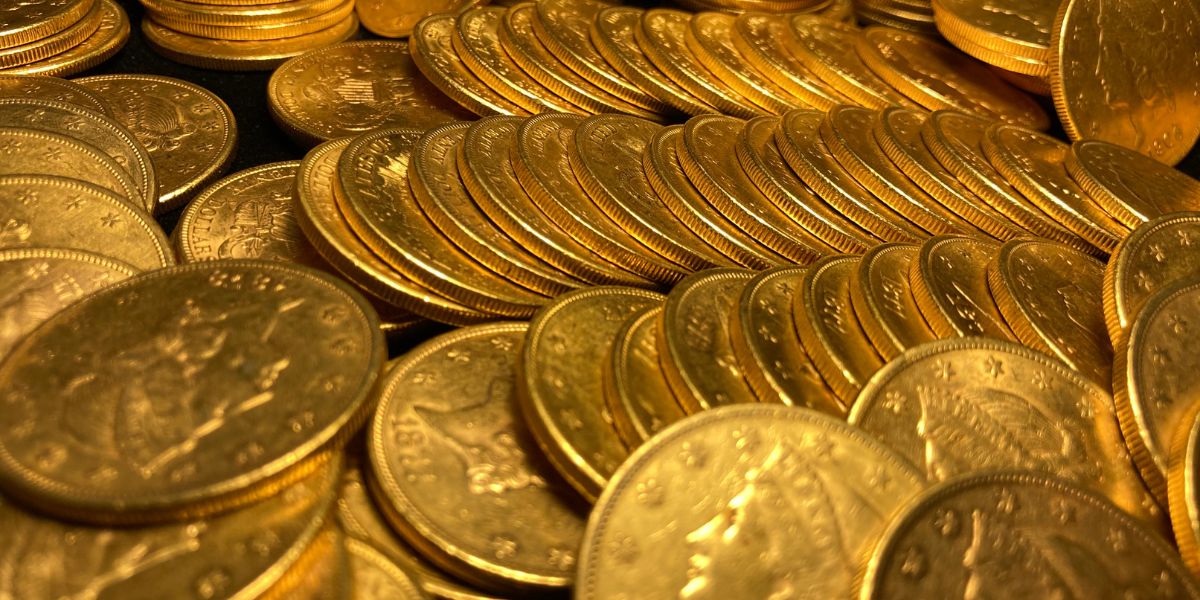
By GovMint :
U.S. made vintage gold coins have a deep and rich history and are a popular option for coin enthusiasts. Whether you’re a novice or an expert coin collector, this guide will cover valuable tips and insights you need to know when collecting vintage gold coins.
Let’s get right into it!
Table of Contents
- The History of Vintage Gold Coins & Their Face Value
- What Are Vintage Gold Coins?
- How Much Gold Is In a Pre-1933?
- What Is Special About Pre-1933 Gold Coins?
- Why Collect Vintage Gold Coins?
- Is It Worth Buying Pre-1933 Gold Coins?
- How to Collect Vintage Gold Coins
- What Should I Look for When Collecting Vintage Gold Coins?
- 3 Ways to Collect Vintage Gold Coins
- What to Avoid When Collecting Vintage Gold Coins
- Where to Buy Vintage Gold Coins
The History of Vintage Gold Coins & Their Face Value
Vintage gold coins have a unique history. In 1933, President Franklin D. Roosevelt started a program that restricted the private use of gold. Then, in 1934, Roosevelt signed the Gold Reserve Act—a law that banned citizens from holding or hoarding gold. This law was passed to help build the federal government’s gold reserves and strengthen an already struggling economy due to the Great Depression. Ultimately, this resulted in many gold coins being taken and melted down for the government’s use.
Vintage gold coins also have varying face values. Specifically, the following pre-1933 gold coins list the following face values for each type:
- Indian Quarter Eagle, Liberty Head - $2.50
- Indian Princess - $3
- Half Eagle, Liberty Head, Indian Head - $5
- Gold Eagle - $10
- Liberty, Saint Gaudens’ Double Eagle - $20
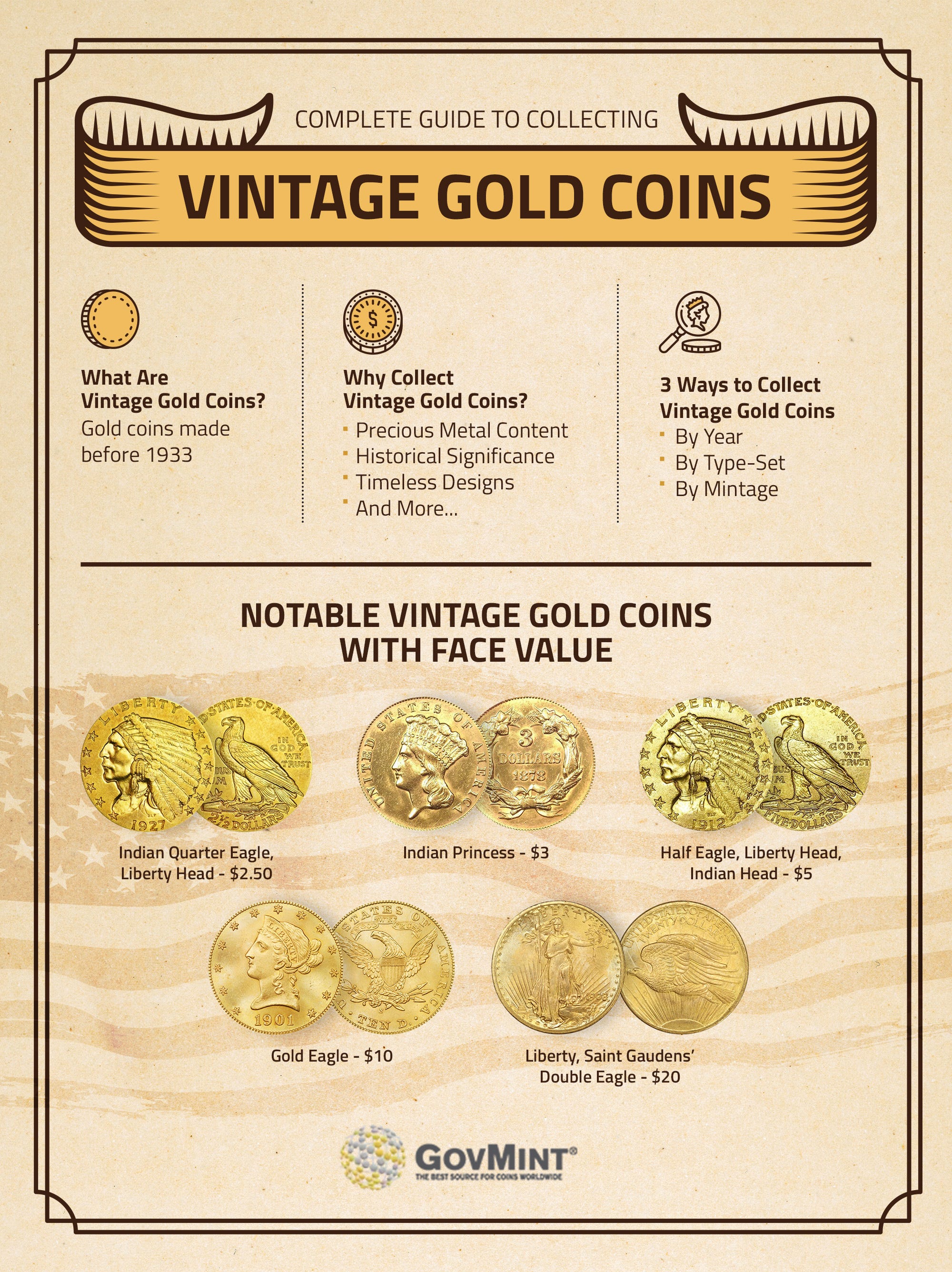

What Are Vintage Gold Coins?
Vintage gold coins are gold coins that were made before 1933 (sometimes referred to as “pre-1933 gold coins”). These coins hold a captivating historical significance and are highly sought after by collectors and stackers alike due to their iconic designs, high precious metal content, and compelling histories.
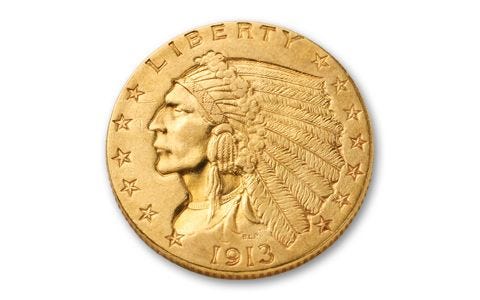

How Much Gold Is In a Pre-1933?
Vintage gold coins made before 1933 often held a high gold composition ratio of approximately 90%, with 10% copper. However, the weight of gold for each U.S. gold coin varies, which usually corresponds to its denomination. For example, the $20 Saint-Gaudens Double Eagle contained almost one ounce of pure gold, while the $10 Liberty Head gold coin contained about half an ounce.
What Is Special About Pre-1933 Gold Coins?
Pre-1933 gold coins are considered special for several reasons. For instance, their high gold content and the fact that the amount that exists today are limited. Despite millions of U.S. gold coins being minted, many were melted down after Roosevelt’s 1933 executive order. Vintage gold coins also have deep historical ties to events such as the Great Depression, which makes them all more special to collectors. As unique physical ties to American history, pre-1933 gold coins harken back to a time when gold coinage circulated and was used in everyday commerce, making them appealing additions to any collection or hoard of precious metal treasures.
Why Collect Vintage Gold Coins?
The reasons for coin collectors can differ, but some include sentimental or historical reasons as we mentioned previously.
Collecting vintage gold coins is a passion that transcends time and resonates with the allure of history, craftsmanship, and precious metal content. Vintage gold coins offer a tangible connection to bygone eras, showcasing exquisite design and artistry reflective of their time. Moreover, the thrill of uncovering potentially rare or unique pieces adds an element of discovery and excitement to the pursuit of collecting pre-1933 U.S. gold coins, making it a rewarding and enriching endeavor for collectors and precious metal enthusiasts alike.
Is It Worth Buying Pre-1933 Gold Coins?
As a coin collector, you will need to determine what you want to achieve through collecting vintage gold coins and whether it is worth it to you. Factors such as your budget, your goals, if you plan to gift your gold coins to someone, and when or if you ever plan to sell your coins at a later date, are examples of what you should strongly consider to determine whether it’s worth buying pre-1933 gold coins.
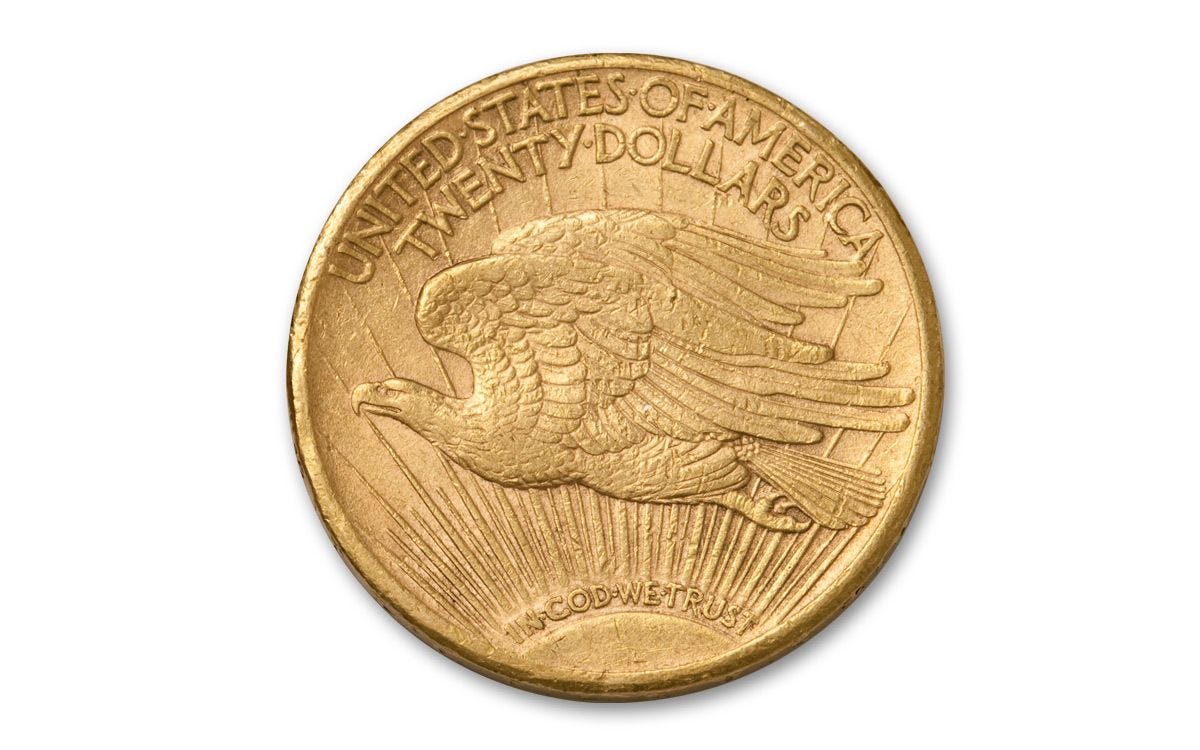

What Should I Look for When Collecting Vintage Gold Coins?
When diving into the world of collecting vintage gold coins, collectors should prioritize several key aspects to ensure they acquire authentic and fairly priced coins. Factors include meticulous attention to the coin’s condition, its gold content, mintage, details such as dates and mint marks, and minting errors. Paying attention to these nuanced details will help you to navigate the coin-collecting market and ensure you purchase authentic and fairly priced coins.
#1. By Year
This is one of the most popular and conventional methods used to collect gold coins. The strategy involves collecting pre-1933 gold coins by the year they were minted. It allows collectors to chronologically organize their coins and observe the evolution of designs and their history over different periods.
#2. By Type-Set
Another popular strategy is to collect vintage gold coins by their design or type. Here’s an example of what that may look like. An 8-piece type set may include the following kinds of pre-1933 gold coins: four Liberty Head designs (Quarter Eagle, Half Eagle, Eagle, and Double Eagle) , one Saint-Gaudens Double Eagle, and three Indian Head designs (Quarter Eagle, Half Eagle, and Eagle).
#3. By Mintage
Collectors often choose to build their collection based on the mintage or difficulty of acquiring a vintage gold coin (easy to hard). If a U.S. gold coin has what is considered a low mintage and demand for that particular issue is high, chances are, that coin will be more difficult to get because of the cost.
What to Avoid When Collecting Vintage Gold Coins
Be sure when buying vintage U.S. gold coins that you verify their authenticity, consulting with reputable coin dealers or numismatic experts for authentication. Additionally, review the coin’s condition, avoiding those with excessive wear or damage.
When you’ve acquired a coin, avoid storing it in a bag or container with other coins where they can easily scratch against each other. You want to keep them stored in a safe place, such as a coin album.
You will also want to avoid handling or touching your coins directly with your hands or fingers. The oils can potentially damage your coins or leave a residue. If your coins are already dirty, it’s best to leave them as they are, or seek a professional, as attempting to clean them yourself can do more harm than good. Improperly cleaning a coin can ruin its appeal if you ever decide to resell it.
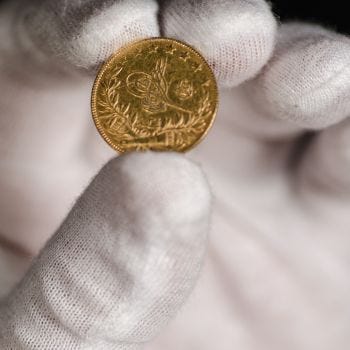

Where to Buy Vintage Gold Coins
There are numerous places you can go to buy authentic vintage gold coins. However, if you want to ensure you are buying fairly priced, authentic, and certified pre-1933 U.S. gold coins, then GovMint is one of the best places to visit. We sell vintage gold coins such as the Liberty and Indian Head gold coins, along with other numismatic products, and we offer a wide variety of professionally certified options as well. Visit GovMint today to start your vintage gold coin collection.
Resources:
- https://www.federalreservehistory.org/essays/gold-reserve-act
- https://coinweek.com/36-major-us-gold-coin-types-collectors-guide/
- https://www.ngccoin.com/price-guide/coin-melt-values.aspx?MeltCategoryID=1&BaseMetal=US-Gold-Coin
- https://www.ngccoin.com/news/article/8237/
- https://www.thesprucecrafts.com/most-valuable-us-gold-coins-4160742
- https://www.cbsnews.com/news/reasons-to-buy-gold-bars-and-coins/
Copyright 2020 GovMint. All Rights Reserved. GovMint.com does not sell coins and numismatics as investments, but rather as collectibles. Please review GovMint’s Terms and Conditions, Terms of Use and Privacy Policy before using this website and prior to purchasing from GovMint. All website content is for reference use only and does not constitute investment, legal or financial advice. We encourage the sharing and linking of our information but reproduction of our news and articles without express permission is prohibited. Instead of reproducing, please provide the link to the original article or use the share buttons provided.






